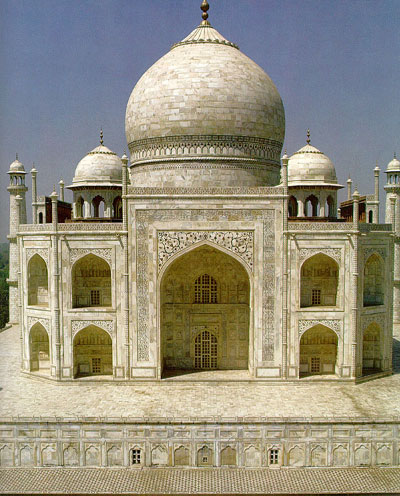

Unit 5

English 203:
Literature of the NonWestern World
 |

Unit 5 |

English 203: Literature of the NonWestern World |
| Introduction | .Explication | Questions | Review |
Reading:
567-624
India's Heroic Age: 567-75
Ramayana: 576-612
Bhagavad-Gita: 612-24
Introduction:
India is a civilization as old as China. The Ramayana dates from 550 bce. Arguably it has been even more influential than China. Its cultural influence stretched from Persia (Iran) through Indonesia & up to Viet Nam. Indian culture influenced the lives of at least as many people as Chinese culture. Buddhism was an Indian program adopted by China. So the historical influence was more from India to China rather than the reverse. India was even more isolated than China. The Himalayas kept the 2 cultures apart. The ancient Greek world knew about India (remember Alexander the Great?) but the distances were too great to sustain regular cultural & economic relations.
What is the thing that most fundamentally characterizes Hindus? The thing they would be most reluctant to give up? The answer is caste. Sometimes we talk about "accidents of birth" to "explain" differences in intelligence, talent, health, or personality. There are no "accidents of birth" in a Hindu outlook. Your present condition is caused by karma accrued not merely in this incarnation, but in a number of previous incarnations. Dharma & karma are reciprocating forces. Dharma specifies obligations. If you meet the obligations you receive the benefit of good karma, which defines a new stage of growth & development that has new requirements or dharma. This may sound arcane, but it is familiar. Students have various duties & obligations (dharma). If they fulfill them, they graduate & generally get jobs that specify new & different duties & obligations. If you drop out or fail to meet the obligations of dharma: you drop down to a lower or earlier developmental condition where you are confronted with easier or more elementary duties (dharma). Caste is the the most objective measure of karmic development. When Americans "size someone up" perhaps the first they consider is race. When the British "size someone up" the first they consider is status or class. When Indians "size someone up" the first thing they think of is caste.
Hindus call their religion or outlook Sanatana Dharma, which means the eternal, inherent order (dharma) in things (cf. Greek idea of logos). This (& not God) is the authority for moral law (what you must do). It is very much concerned with the process of human growth & development. In fact you would do well to think of Hinduism as advice or recommendations concerning stages of human growth & development. Thus the sanction for failing to do what you ought to do is not punishment inflicted from the outside but a subjective loss. You simply do not "get it." For example, no matter how sexual experience is explained to prepubescent children, they cannot "get it," because they have not had the experience. Moving through pubescence, leaving childhood to become adult, is an apt model for karmic evolution & the associated stages prescribed by varna-dharma & ashrama-dharma.
Hindu Terms:
Dharma: obligation, what you need to do, because it is the pattern of human growth & development. Dharma has 2 major forms: varna-dharma & asrama-dharma. When dharma has been identified in any situation, performing it produces good karma, refusing to perform or doing so badly produces bad karma.
Varna-dharma:caste:
Brahmins: intellectualsKhastriyas: military, power
Vaiysha: money, business
Sudra: servants, working class
Pariah: outcasts
students: prepubescent
householder: married, employed
retired: advisor
sadhu: liberated
Karma: karma is like fuel for life to burn. It is also a set of habits, character traits, & propensities. One’s jiva (ego) is entirely composed of karma. The Hindu project or goal is to burn up all karma, which means the destruction of the jiva & the liberation of the atman.
Vishnu: the god who sustains maya or our world thus giving us the chance to burn up our karma to become liberated. Vishnu periodically sends his avatar into the world to illustrate Dharma. These have included Rama (& Sita) & Krishna (& Radha).
Hindu
Outlook:
Anicca: the universe (or God) is a verb, not a noun. Because it is a process, no shape or form or noun persists indefinitely.Anatta: change includes you. You are not exempt for the process of change. You have no single, ahistorical identity (no soul, no ego) that can persist for long.Dukkha: in our deluded state we believe that our ego is stable & exempt from change & that it can possess relationships, money, experiences, etc. for eternity. Because this is impossible, we experience life as disappointing, as suffering.
Click on the next section:
| Explication |